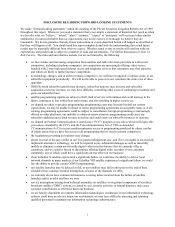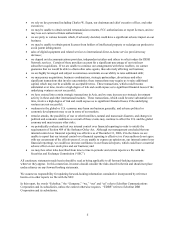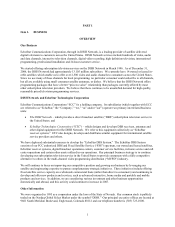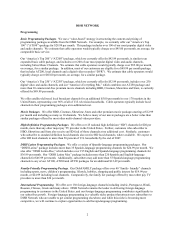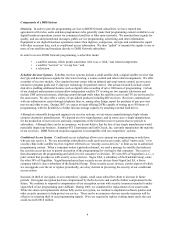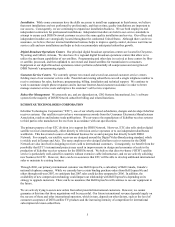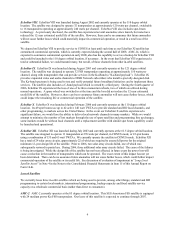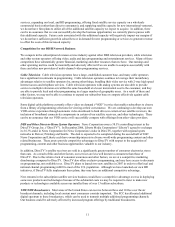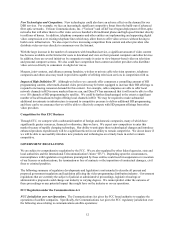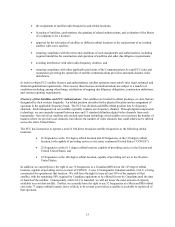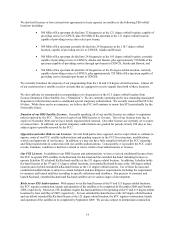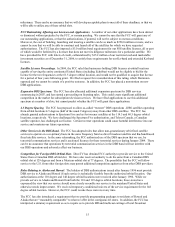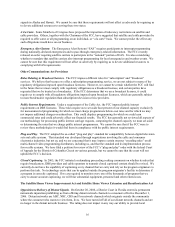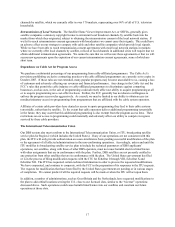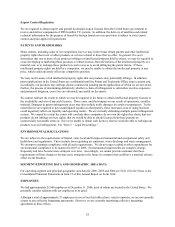Dish Network 2006 Annual Report Download - page 18
Download and view the complete annual report
Please find page 18 of the 2006 Dish Network annual report below. You can navigate through the pages in the report by either clicking on the pages listed below, or by using the keyword search tool below to find specific information within the annual report.8
per channel, switchable to 16 transponders operating at over 230 watts per channel, and was equipped with a total of
44 transponders to provide redundancy. Prior to 2006, TWTA anomalies caused 22 transponders to fail. During
April and October 2006, further TWTA anomalies caused the failure of four additional transponders. As a result, a
maximum of 18 transponders are currently available for use on EchoStar III, but due to redundancy switching
limitations and specific channel authorizations, we can only operate 15 of the 19 FCC authorized frequencies we
have the right to utilize at the 61.5 degree location. While we do not expect a large number of additional TWTAs to
fail in any year, and the failures have not reduced the original minimum12-year design life of the satellite, it is likely
that additional TWTA failures will occur from time to time in the future, and those failures will further impact
commercial operation of the satellite.
EchoStar IV. EchoStar IV was launched during May 1998 and currently operates at the 77 degree orbital location,
which is licensed by the government of Mexico to a venture in which we hold a minority interest. The satellite was
originally designed to operate a maximum of 32 transponders at approximately 120 watts per channel, switchable to
16 transponders operating at over 230 watts per channel. As a result of past TWTA failures, only six transponders
are currently available for use and the satellite has been fully depreciated on our books. There can be no assurance
that further material degradation, or total loss of use, of EchoStar IV will not occur in the immediate future.
EchoStar V. EchoStar V was launched during September 1999 and currently operates at the 129 degree orbital
location. The satellite was originally designed with a minimum 12-year design life. As previously disclosed,
momentum wheel failures in prior years, together with relocation of the satellite between orbital locations, resulted in
increased fuel consumption. These issues have not impacted commercial operation of the satellite, but have reduced
the remaining spacecraft life to less than two years as of December 31, 2006. Prior to 2006, EchoStar V also
experienced anomalies resulting in the loss of six solar array strings. During July 2006, the satellite lost an additional
solar array string. The solar array anomalies have not impacted commercial operation of the satellite to date. Since the
satellite only has a remaining life of approximately two years, the solar array failures (which would normally have
resulted in a reduction in the number of transponders to which power can be provided in later years), are not expected
to reduce the current remaining life of the satellite. However, there can be no assurance that future anomalies will not
cause further losses which could impact commercial operation, or the remaining life, of the satellite. See discussion of
evaluation of impairment in “Long-Lived Satellite Assets” in Note 4 in the Notes to the Consolidated Financial
Statements in Item 15 of this Annual Report on Form 10-K.
EchoStar VI. EchoStar VI was launched during July 2000 and is currently stationed at the 110 degree orbital location
as an in-orbit spare. The satellite was originally equipped with 108 solar array strings, approximately 102 of which are
required to assure full power availability for the original minimum 12-year design life of the satellite. Prior to 2006,
EchoStar VI experienced anomalies resulting in the loss of 15 solar array strings. During 2006, two additional solar
array strings failed, reducing the number of functional solar array strings to 91. While the design life of the satellite has
not been affected, commercial operability has been reduced. The satellite was designed to operate 32 transponders at
approximately 125 watts per channel, switchable to 16 transponders operating at approximately 225 watts per channel.
The power reduction resulting from the solar array failures limits us to operation of a maximum of 26 transponders in
standard power mode, or 13 transponders in high power mode currently. The number of transponders to which power
can be provided is expected to continue to decline in the future at the rate of approximately one transponder every three
years. See discussion of evaluation of impairment in “Long-Lived Satellite Assets” in Note 4 in the Notes to the
Consolidated Financial Statements in Item 15 of this Annual Report on Form 10-K.
EchoStar VII. EchoStar VII was launched during February 2002 and currently operates at the 119 degree orbital
location. During March 2006, the satellite experienced an anomaly which resulted in the loss of a receiver. Service
was quickly restored through a spare receiver. These receivers process signals sent from our uplink center, for
transmission back to earth by the satellite. The design life of the satellite has not been affected and the anomaly is
not expected to result in the loss of other receivers on the satellite. However, there can be no assurance future
anomalies will not cause further receiver losses which could impact the useful life or commercial operation of the
satellite. In the event the spare receiver placed in operation following the March 2006 anomaly also fails, there
would be no impact to the satellite’s ability to provide service to the continental United States (“CONUS”) when
operating in CONUS mode. However, we would lose one-fifth of the spot beam capacity when operating in spot
beam mode.


